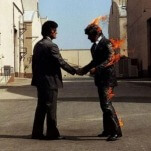Country Soul by Charles Hughes
There’s a Redneck in the Soul Band

The many petulant responses to the landmark civil rights film Selma remind us that white moviegoers often prefer their black stories sweetened with white heroes. We’ve seen the box office reliability of that approach demonstrated in films of questionable historical balance from Cry Freedom to Mississippi Burning to The Help. Likewise, as Charles Hughes explains in Country Soul: Making Music and Making Race in the American South, the “first generation” of scholarship on southern soul music comforted white readers with a triumphant story of interracial cooperation, and a handful of white heroes that guided (or, as Hughes would argue, misguided) the narrative.
Peter Guralnick’s seminal Sweet Soul Music (1986) tells the story of Memphis soul largely through the eyes of white Stax Records guitarist Steve Cropper, a key figure in the studio’s legendary integrated house band, Booker T. and the M.G.’s, that helped produce dozens of hits for black artists. Guralnick also identifies white songwriter-producer Dan Penn as Sweet Soul Music’s unsung “white hero,” emblematic of the connections he draws between soul music’s integrated origins and the “southern dream of freedom.” In several stunningly productive years of interracial in-studio harmony, according to Guralnick, just about the only guy to rock the boat was a black non-musician named Ted White, first husband of Aretha Franklin. White’s drunken antagonism toward white musicians ruined Franklin’s first (and, as it turned out, only) recording session in Rick Hall’s legendary FAME Studios in Muscle Shoals, Ala. The incident nearly derailed the recording of her classic first album on Atlantic Records, I Never Loved a Man the Way I Love You.
To a large extent, while telling an essential part of the story, those early southern soul books presented white heroes and black talents, who came together not only to make groundbreaking music but also to model interracial equality and integration with an ease and fluidity rarely seen outside the studio walls in the American South at that time. Soul music’s peak period offers the heart-in-the-right-place wishful thinker an almost-too-tantalizing confluence of historical forces. The classic era of southern soul spans roughly 1963-68—not only pivotal years in the civil rights movement, but also the years in which white and black musical tastes aligned more closely than ever before, and arguably ever since. The popularly held belief that the legendary southern soul performers of that era—Otis Redding, Aretha Franklin, Solomon Burke, Wilson Pickett, Sam & Dave, Percy Sledge—recorded their biggest hits with either all-white or integrated studio bands, also rings true. And the studios at the center of it all took pride in promoting themselves as beacons of interracial cooperation. That golden era ended bitterly, so the Cropper-Guralnick story goes, when the assassination of Martin Luther King, Jr. in 1968 brought new hostilities into the studio, as the push for integration gave way to Black Power, and black musicians lost their tolerance for working with whites.
Country Soul, a brilliant new exploration of the racial politics of the southern music recording scene from the early 1960s to the early 1980s, paints a less black-and-white picture than Sweet Soul Music or any other book on southern music that’s come before it. While Country Soul’s lack of a white hero may disappoint some readers, Hughes tells a much richer, more inclusive story about the common sources of black-identified soul music and white-identified country music. Hughes traces the narrative from African-American singer Arthur Alexander’s too-country-for-black-radio “You Better Move On” (1961) to the curious country-disco hybrid hits of the early ’80s (Johnny Lee’s “Lookin’ for Love” and Dolly Parton’s “9 to 5”). Country Soul may also surprise aficionados of southern soul history with its lack of a lovingly rendered account of the transcendent moment when then-unknown Otis Redding unleashed the first magical, deceptively hesitant syllables of “These Arms of Mine.” Hughes, in fact, devotes more pages to the recording of the Osmonds’ “One Bad Apple” than to any Redding session. And what fascinating pages they are.
Hughes identifies the three cities that begat the South’s most successful music studios—Memphis, Muscle Shoals and Nashville—as the “country-soul triangle,” and focuses on the “interconnected recording economy” generated by the musicians and producers who recorded there. “Backing up everyone from Aretha Franklin to Hank Williams Jr.,” the musicians Hughes describes—some black, some white—created records that “made each city’s ‘signature sound’ into a marker of quality and authenticity.”
But whatever our preconceived notions about music as a lifestyle, and regardless of the mastery, versatility and originality the musicians of the country-soul triangle brought to their efforts, making records is work, and working in a recording studio is a job. Accordingly, Hughes treats the triangle studios as a workplace with its attendant labor issues. Far from “redeeming the south from its racist past,” these integrated workplaces didn’t differ all that much from other southern workplaces in terms of working conditions. “Despite the utopian claims,” Hughes writes, “African American musicians consistently objected to mistreatment from whites and worked to equalize the racial dynamics of southern studios from the very beginning.”
-

-

-

-

-

-

-

-

-

-

-

-

-

-

-

-

-

-

-

-

-

-

-

-

-

-

-

-

-

-

-

-

-

-

-

-

-

-

-

-









































